John Hurrell – 31 August, 2020
Presented here with tensegrity as a spatial metaphor for an ecologically balanced synthesis, Cheng and Cooper's collaborative sculptures demonstrate the suspension of linear elements inside netted arrangements of adjusted tensions—using coloured plastic pipes and tightened packaging tape. Most of the large threaded constructions by the artists are hanging in the front window, while the smaller ones by Cheng alone are positioned on a shelf in the Grey Room.
In this unusual show of design-driven drawings, pollution-scummed monoprints, blue cynotypes of plants and rubbish, functional sculptures (usually with recycled materials) and ecological preoccupations, Xin Cheng and Eleanor Cooper fully utilise the four narrow spaces in the confining Mokopōpaki venue—including the shower. Often focussing on the problem of contaminated ‘greywater‘ water recycling (when unregulated), the two artists ponder problems to be solved within a normal domestic environs—functional dilemmas scrutinised and clarified as a way of discovering solutions.
Presented here with tensegrity (what the sculptor Kenneth Snelson called ‘floating compression’) as a spatial metaphor for an ecologically balanced synthesis, Cheng and Cooper’s collaborative sculptures demonstrate the suspension of linear elements inside netted arrangements of adjusted tensions—using coloured plastic pipes and tightened packaging tape (strapping). Most of the large threaded constructions by the artists are hanging in the front window, while the smaller ones by Cheng alone (featuring batons, sticks or diminutive beams that have thread hooked into their split ends) are positioned on a shelf in the Grey Room. They seem to symbolise diverse elements (like types of tree) coexisting in harmony.
Eleanor Cooper‘s two beautiful seaweed-motiffed poles—designed for keeping protective adult sealions at bay while DOC divers tag their pups—are based on karate (bo) staffs; a gorgeous aesthetic advancement on the usually-issued plain broom handles. Nearby is a taut vertical cord bearing 3D printed bird whistles, designed to mimic the cries of koekoea (long-tailed cuckoos).
Some of the tools we see are quite mysterious in terms of functionality. On a transparent Perspex shelf resting on two open empty ring-binder folders (wittily marbled to reflect the monoprints next door) that are screwed to the grey wall, is a cutting board and two old coloured folders of New Zealand art mags.
Resting on these planes is a strip of felt made of white cat hair, some spatulas and wooden blades, a tongue compressor, what seems to be a collection of surface scrapers (or maybe guitar capos), and an enigmatic vesica piscis shape (from bound sharpened saplings). The latter contains a pumice ball. Nearby is another ball carved from cork. That the magazines are closed and serving a practical purpose seems a drolly humorous touch from Cheng the pragmatist. A wry comment on the relevance of art history perhaps?
In the Brown Room, butted against a lintel above a door at the far end, is a clamp used for gluing wood. The objects to be fastened are sandwiched between two solid planes that are linked by two pairs of twisted cords. These are tightened by inserted turnable objects that serve as handles, so pressure within the ‘vice’ is maximised and maintained.
Inside on the glass gallery (entrance) door are some linear coloured pencil drawings Cheng has done when thinking about various functional projects. Quickly executed, austere and spontaneous, they exude confidence in problem solving. Drawing clearly is a tool for thinking, not for showing the results of thinking. An ongoing muscular procedure exploring the productive positioning of materials and possible vectors of energy.
John Hurrell
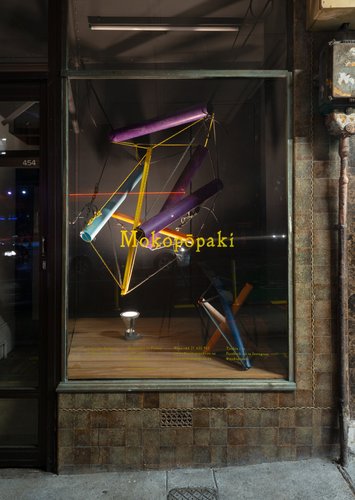
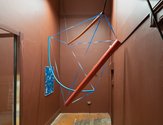

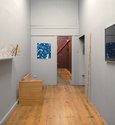
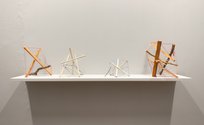
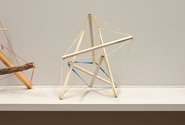
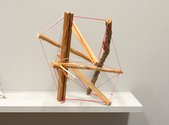


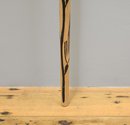


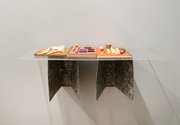
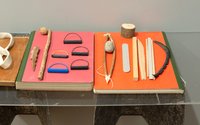

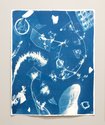
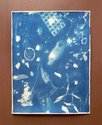

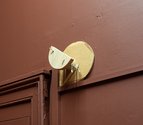
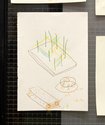
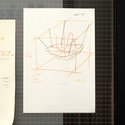
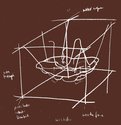
 Advertising in this column
Advertising in this column Two Rooms presents a program of residencies and projects
Two Rooms presents a program of residencies and projects



This Discussion has 0 comments.
Comment
Participate
Register to Participate.
Sign in
Sign in to an existing account.